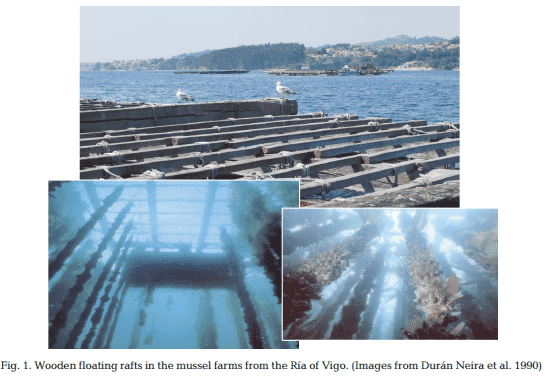Galician Rías (NW Spain) are one of the largest productive areas of mussels in the world (SánchezMata & Mora 2000, Caballero Miguez et al. 2009). The culture is carried out in floating rafts made with beams of eucalyptus wood supporting submerged cords, to which mussels attach and grow (Fig. 1). The raft maintenance and cleaning is usually performed in situ with tars or waterproof paints. Mussels, as filtering organisms, ingest particulate and dissolved forms of pollutants along with food, concentrating these pollutants to levels well above those in the surrounding seawater (Baumard et al. 1999).
Therefore, the spillage of these substances around rafts entails a direct pollution risk on the immediate environment and the mussel culture itself, which can affect not only the quality of the product but also food safety if these chemicals are accumulated above the recommended values for human consumption (WHO 1991). Thus, it seems necessary to evaluate the toxicity of these compounds.The compounds described are complex mixtures whose toxicological evaluation is difficult due to interactions of chemical, physical and physiological factors. Only their soluble or dispersed fraction in the water column is bioavailable and can be accumulated in marine organisms, exerting its toxic effect (McElroy et al. 1989).
One of the most harmful effects of most toxic pollutants is mutagenicity, which has been related to carcinogenesis (Mortelmans & Zeiger 2000, Barton et al. 2005). Although toxicity is a broad concept that includes many other harmful effects, all compounds inducing mutagenesis or carcinogenesis are considered toxic. This consideration justifies that mutagenicity and carcinogenicity have been widely accepted for assessing the toxicity of chemicals. Based on these 2 effects, several authors have established toxic equivalency factors for each individual polycyclic aromatic hydrocarbon (PAH) relative to Benzo(a)pyrene, which is the most toxic PAH (Nisbet & La Goy 1992, US EPA 1993, Villeneuve et al. 2002).
The toxic equivalency of a mixture can be calculated from these factors. However, this method does not consider physical or physiological interactions that may attenuate or enhance the mixture’s toxicity. Therefore, in vivo assays, such as mutagenicity tests, would better reflect a mixture’s actual toxicity. The most commonly used mutagenicity test for the analysis of chemical compounds with legal recognition is the one described by Ames using genetically modified strains of Salmonella typhimurium (Ames 1971, Ames et al. 1975, Maron & Ames 1983, Mortelmans & Zeiger 2000).
However, this bacterium has low survival in the presence of salts, so marine bacteria adapted to high osmotic pressures seem more suitable to evaluate chemical toxicity in marine environments (Czyz et al. 2002, Wegrzyn & Czyz 2003, Ohe et al. 2004, Podgórska & Wegrzyn 2007, Chec et al. 2008). For this reason, other mutagenicity assays using marine bacteria have been developed, such as the one based upon detection of neomycin-resistant mutants of Vibrio harveyi.
The effectiveness of this assay has been compared to the Ames test, showing the highest sensitivity in samples with sea wa ter (Czyz et al. 2000, 2002, 2003, S?oczynska et al. 2010, Ruiz et al. 2013). Biodegradation of toxic compounds by living organisms is conducted by microsomal enzymes that are NAD(P)H-de pendent (reductases and cyto - chromes P450), which produce compounds that are more soluble and easy to remove. However, these products are often more toxic than the parent compounds, resulting in a metabolic activation or bio - activation of toxicity (Lehr & Jerina 1977, Stegeman 1981, López-Barea & Pueyo 1998).
Therefore, the mutagenic ability of the metabolic products of these compounds would indicate the real toxic potential of the compounds for organisms.A direct relationship among seawater mutagenicity from aquaculture farms, accumulation of high concentrations of pollutants in cultured mussels and development of gonadal neoplasias in these organisms has been shown by our group in previous papers focused in the Ría of Vigo (Ruiz et al. 2011, 2013). The present work is a study of the composition and toxic risk of 4 compounds generally used in maintenance and cleaning of floating rafts in order to identify their pollutant contribution in aquaculture areas and improve mussel farming practices, ensuring their sustainability as well as the product quality and consumer safety.
February 2015





